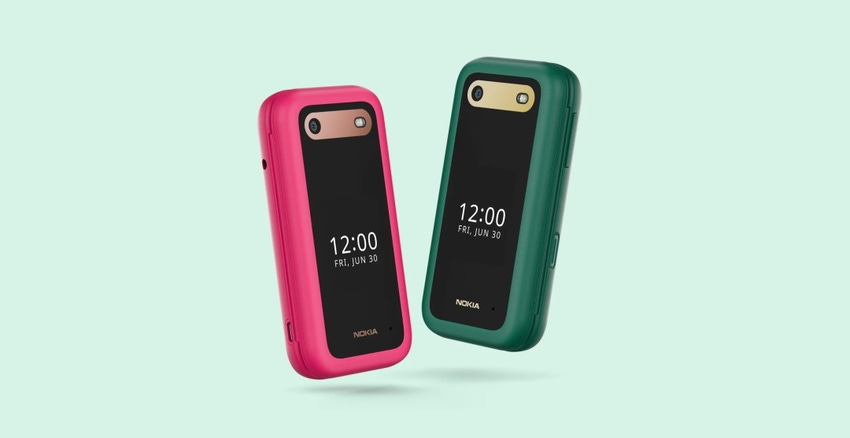As HMD drops a couple of new barebones flip phone models, it claims millions of Nokia feature phones are sold monthly as consumers ‘crave going back to basics.’
May 30, 2023

As HMD drops a couple of new barebones flip phone models, it claims millions of Nokia feature phones are sold monthly as consumers ‘crave going back to basics.’
Nokia was once probably the most well known phone brand in the world in the early noughties, before touch screen smartphones came along and flipped over the apple cart, so to speak. These days it makes its money primarily from selling network infrastructure to operators – but ask anyone on the street and they’ll probably recognise them as a phone brand to this day, perhaps partly prompting a rebrand earlier this year.
This lingering perception probably is not helped by the fact there are still new Nokia branded phones being launched, though now HMD Global makes them presumably under some sort of licensing deal. Today it’s announced two new Nokia 2660 Flip phones in Pop Pink and Lush Green, no less.
In terms of specs, it’s what they don’t do rather than what they do do that’s the selling point – the clamshell device has a rear camera ‘for lo-fi Y2K style pictures’, can do SMS and calls, and that’s basically all you can do on it. Except for playing snake.
The inability to run Instagram, TikTok, or any other data-gobbling app is the pitch here – we’re told Gen Z and Millennials ‘are choosing Flip phones to limit their smartphone screen time for their own mental wellbeing.’ The idea being perhaps doomscrolling social media and having every form of conceivable digital stimulus in your pocket may have some knock on psychological effects. An ancillary bonus of this spartan blower is listed as a battery that lasts for weeks, which is also nice.
HMD says it is riding a digital detox wave and that it’s flip phone market share doubled between 2021 and 2022, and it expects further growth in 2023. It also says the feature phone market is expected to grow by 5% in North America alone in the next five years.
“There’s been a surge of interest in Flip phones, and we believe that the interest is coming from a need to take a break from the constant flow of incoming digital notifications, social media posts and more,” said Lars Silberbauer Chief Marketing Officer from HMD Global. “People want more simplicity, more face-to-face time, more time to think, and time to have an uninterrupted conversation! I’m sure we all have examples where a beautiful life moment has been spoiled by a distraction or notification.
“That’s why we are re-introducing the Nokia 2660 Flip, to give people these important beautiful life moments back.” The original Nokia 2660 Flip launched in 2007, and the first ever Nokia Flip phone launched in 1998. However, 25 years on from the first ever launch of a Nokia flip phone, consumers are looking to limit their screen time and reconnect with each other, themselves and their surroundings.”
In terms of how big this trend is, there seems to be some evidence for the fact that in particular younger types are picking up these dumbphones, though perhaps in addition to rather than in place of an internet enabled smartphone.
The WSJ reports on how low-end models are experiencing ‘a renaissance as budget second phones’ and going on about it appears to be something of an online trend with influencers (not that you’d be able to check it out on an internet-less phone). The trend has also been reported on by the BBC and elsewhere – though it remains largely anecdotal as it’s hard to list ‘reasons for buying’ in global phone shipment stats.
Hipster-ish youth movements aside, most feature phone sales will presumably represent a decision of necessity or economy perhaps in developing nations rather than anything to do with digital detoxes in rich western countries, and retrograde phones are unlikely to come back as the dominant phone type in those markets.
However the trend is interesting in so much as it relates to how younger generations in particular are coming to terms with the potential down sides of too much social media and its impacts on actual social interactions and perhaps mental health. Opting to leave the iPhone at home and scooping up the internet-less flip phone when going for a night out with friends could be a more healthy way to socialise. Still, it’s not ideal if you need to book an Uber home.
Get the latest news straight to your inbox. Register for the Telecoms.com newsletter here.
About the Author(s)
You May Also Like








.png?width=300&auto=webp&quality=80&disable=upscale)


_1.jpg?width=300&auto=webp&quality=80&disable=upscale)


.png?width=800&auto=webp&quality=80&disable=upscale)